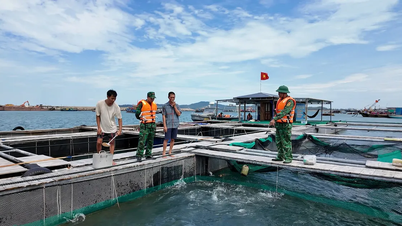On the morning of August 31, the Institute for Development Strategy (VIDS), Ministry of Planning and Investment in collaboration with Konrad-Adenaeur-Stiftung Vietnam (KAS) announced the Report on the Assessment of the 500 Largest Private Enterprises in Vietnam (VPE500) in the period 2021-2022, the period when the economy faced the COVID-19 shock.

Policies for businesses need to continue to be improved in a way that not only facilitates businesses in entering the market but also helps businesses survive and grow. Photo: bnews.vn
Mr. Florian Constantin Feyerabend, Chief Representative of Konrad-Adenauer-Stiftung Vietnam, said that the report not only analyzes how the largest private enterprises in Vietnam have changed in that context and their resilience, but also answers the question of whether they are a pillar for the development of private enterprises in general.
As of December 31, 2021, Vietnam had 694,200 private enterprises, accounting for 96.6% of the total number of operating enterprises, attracting 58.1% of the workforce, accounting for 59.3% of assets and generating 57.8% of net revenue of the business sector.
Private enterprises are mostly small and medium-sized enterprises established after the reform. By the end of 2021, only 0.22% of enterprises had a scale of 500 employees or more, lower than the general rate of 0.52% as well as 8.29% of foreign direct investment (FDI) enterprises and 19.52% of state-owned enterprises.
Representative of the research team, Dr. Nguyen Toan Thang, Head of the International Relations Department, VIDS, said that although appearing in 53/63 provinces/cities, VPE500 is concentrated in the Red River Delta and Southeast regions (accounting for about 75%) and has a slight increasing trend. In general, VPE500 is being formed based on the advantages of infrastructure, resources and markets of localities. VPE500 is distributed in 21/21 level 1 industries, of which the most concentrated are the manufacturing, trade and construction industries.
Comparing the two years of COVID-19 and the previous year, there was a significant change in the number of businesses entering and leaving the VPE500 list. In 2020, up to 97/500 businesses (19.4%) were no longer in the VPE500 ranking of 2019.
These businesses focus on industries that are heavily affected by COVID-19 such as real estate and construction (23/89), trade (15/73), textiles (7/32), food processing (9/70). Only a few industries that still maintain their number in VPE500 are industries that are assessed to benefit from COVID-19 such as information and communication, postal services, electricity production and distribution.
By 2021, another 61 enterprises left the list, bringing the total number of departures after two years to 158, equivalent to 31.6%, and still concentrated in the heavily affected industries above. In addition, even for enterprises that are still in the rankings, their rankings also decreased rapidly, with the rate of falling over 50 places being over 60%. The rate of leaving the general list of the manufacturing and processing industry is 25.3%, lower than the general rate of 28.0%.
Most of the businesses in the banking and insurance sectors still maintain their positions in the rankings, which are also high-ranking groups with little change in rankings. Similarly, businesses in the TOP50 still maintain their rankings and their rankings also change less.
Obviously, during the COVID-19 period, the stability of VPE500 was higher, implying that large enterprises still maintained their position in the market better than the group of small and medium enterprises.
The report also pointed out that, because the VPE500 group performed exceptionally well and maintained a good growth rate compared to domestic private enterprises in general, the level of superiority in terms of scale and average business results of domestic private enterprises.
On average, in the 2019-2021 period, the labor force is 160 times higher and the average total assets of a VPE500 enterprise are approximately 376 times higher than that of domestic private enterprises in general.
Thanks to its scale and outstanding performance, VPE500 accounts for a small proportion of the number of enterprises but contributes greatly to the activities of domestic private enterprises. On average, in the period of 2019-2021, VPE500 only accounts for 0.075% of the total number of domestic private enterprises but creates jobs for 12% of workers, accounts for 28% of total assets, generates 18.4% of gross revenue and contributes 18.4% to the budget of the group of domestic private enterprises.
According to the report, analysis of VPE500 and relations with domestic private enterprises in general shows that it is necessary to have more specific policies to build a force of large private enterprises, develop stably, withstand major external shocks and increase the efficiency of the entire economy .
According to Dr. Nguyen Toan Thang, policies for enterprises in the coming time need to continue to be improved in the direction of not only facilitating enterprises in entering the market but also helping enterprises survive and grow. In particular, large enterprises should be encouraged to invest in improving productivity and gradually shifting to in-depth growth.
Along with that, the Government has economic policies to promote business linkages, encourage large enterprises, state-owned enterprises, FDI enterprises to form joint ventures and partnerships with domestic small and medium enterprises. At the same time, improve the capacity of enterprises to participate in production networks, supply chains, and global value chains; at the same time, it is necessary to encourage and create a movement for each locality to build its own leading private enterprises based on local advantages and expand operations nationwide.
However, Mr. Nguyen Tu Anh, Head of the General Department, Central Economic Committee, said that in order to build private enterprises to lead the market, the Government must introduce policies to support business development.
“We need to filter these 500 businesses, then continue to survey to see what they need, then our report will be more meaningful. For example, businesses want to expand their market or scale or how... to have solutions although this depends on the resources of the business,” said Mr. Tu.
According to VNA
Source



![[Photo] Prime Minister Pham Minh Chinh launched a peak emulation campaign to achieve achievements in celebration of the 14th National Party Congress](https://vphoto.vietnam.vn/thumb/1200x675/vietnam/resource/IMAGE/2025/10/5/8869ec5cdbc740f58fbf2ae73f065076)


























![[Photo] Bustling Mid-Autumn Festival at the Museum of Ethnology](https://vphoto.vietnam.vn/thumb/1200x675/vietnam/resource/IMAGE/2025/10/4/da8d5927734d4ca58e3eced14bc435a3)























![[VIDEO] Summary of Petrovietnam's 50th Anniversary Ceremony](https://vphoto.vietnam.vn/thumb/402x226/vietnam/resource/IMAGE/2025/10/4/abe133bdb8114793a16d4fe3e5bd0f12)

![[VIDEO] GENERAL SECRETARY TO LAM AWARDS PETROVIETNAM 8 GOLDEN WORDS: "PIONEER - EXCELLENT - SUSTAINABLE - GLOBAL"](https://vphoto.vietnam.vn/thumb/402x226/vietnam/resource/IMAGE/2025/7/23/c2fdb48863e846cfa9fb8e6ea9cf44e7)



































Comment (0)